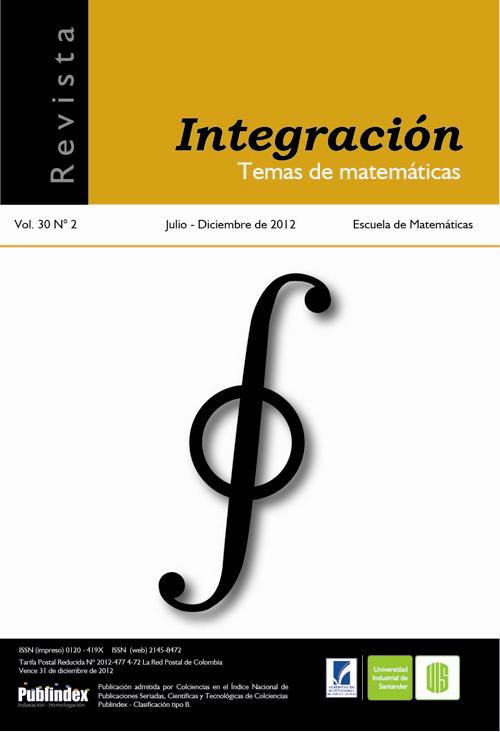Research and Innovation Articles
Generating fractals curves from homomorphisms between languages [ with Mathematica® ]
Published 2012-11-28
Keywords
- Combinatorics on words,
- infinite Fibonacci word,
- homomorphism between languages,
- fractal curves,
- L-systems
- Mathematicar ...More
How to Cite
Ramírez, J. L., & Rubiano, G. N. (2012). Generating fractals curves from homomorphisms between languages [ with Mathematica® ]. Revista Integración, Temas De matemáticas, 30(2), 129–150. Retrieved from https://revistas.uis.edu.co/index.php/revistaintegracion/article/view/2902
Abstract
In this paper we implement with the software Mathematica 8.0 some combinatorial properties of Fibonacci Word, which can be generated from the iteration of a homomorphism between languages.We collect also some graphic properties of the fractal curve associated to this word, which can be generated from drawing rules similar to those used in the L-Systems. All codes used in this paper are presented in detail and then they are applied to generate new fractal curves. We conclude with an alternative way to generate the Fibonacci curve and other curves from characteristics words.
Downloads
Download data is not yet available.
References
[1] Abelson H., diSessa A.A., Turtle geometry, MIT Press Series in Artificial Intelligence, MIT Press, Massachusetts, 1981.
[2] Allouche J.-P., Shallit J.,“The ubiquitous Prouchet-Thue-Morse sequence”, En Ding C., Helleseth T., Niederreiter H., editors, Sequences and their Applicactions, Proceedings of SETA’98, Springer Verlag (1999), 1–16.
[3] Allouche J.-P. Shallit J., Automatic Sequences, Cambridge University Press, Cambridge, 2003.
[4] Allouche J.-P. Skordev G., “Von Koch and Thue-Morse revisited”, Fractals 15 (2007), no. 4, 405–409.
[5] Dekking F.M. “Recurrent sets”, Adv. in Math. 44, (1982), no. 1, 78–104.
[6] Dekking F.M., “Replicating superfigures and endomorphisms of free groups”, J. Combin. Theory Ser. A 32 (1982), 315–320.
[7] Dekking F.M., Mendès M., “Uniform distribution modulo one: a geometrical viewpoint”, J. Reine Angew. Math. 329 (1981), 143–153.
[8] Deshouillers J.-M., “Geometric aspects of Weyl sums”, Elementary and analytic theory of numbers (Warsaw, 1982), Banach Center Publ. 17 (1985), 75–82.
[9] Griswold R.E., “The Morse-Thue Sequence”, Dep. of Computer Science, The University ofn Arizona. http://www.cs.arizona.edu/patterns/weaving/
[10] Von Koch H., “Une méthode géométrique élémentaire pour l’étude de certaines questions de la théorie des courbes planes”, Acta Math. 30 (1906), no. 1, 145–174.
[11] Lothaire M., Combinatorics on Words, Cambridge University Press, Cambridge, 1983.
[12] Lothaire M., “Algebraic Combinatorics on Words”, Encyclopedia of Mathematics and its Applications, Cambridge University Press, Cambridge, 2002.
[13] Lothaire M., “Applied Combinatorics on Words”, Encyclopedia of Mathematics and its Applications, Cambridge University Press, Cambridge, 2005.
[14] Ma J., Holdener J. “When thue Morse meets Koch”, Fractals 13 (2005), no. 3, 191–206.
[15] Monnerot A., “The Fibonacci Word Fractal”, preprint (2009). http://hal.archives-ouvertes.fr/hal-00367972/fr/
[16] Morse M., “Recurrent geodesics on a surface of negative curvature”, Transactions Amer. Math. Soc. 22 (1921), no. 1, 84–100.
[17] Morse M., Hedlund G., “Symbolic Dynamics II: Sturmian Sequences”, Amer. J. Math. 62 (1940), 1–42.
[18] Prusinkiewicz P., Lindenmayer A., The algorithmic beauty of plants, Springer-Verlag. New York, 2004.
http://algorithmicbotany.org/papers/abop/abop.pdf.
[19] Prusinkiewicz P., “Graphical applications of L-systems”, Proceedings of Graphics Interface (ed. Wein M. and Kidd E.M.), Canadian Information Processing Society (1986), 247–253.
[20] Schützenberger M-P., “Une théorie algébrique du codage,” In Séminaire Dubreil-Pisot 1955–56, Exposé No. 15, (1955).
[21] Siromoney R., Subramanian K., “Space-filling curves and infinite graphs”, Graph grammars and their application to computer science (ed. Ehrig H., Nagl M. and Rozenberg G.), Second International Workshop, Lecture Notes in Computer Science 153, Springer-Verlag, Berlin (1983), 380–391.
[2] Allouche J.-P., Shallit J.,“The ubiquitous Prouchet-Thue-Morse sequence”, En Ding C., Helleseth T., Niederreiter H., editors, Sequences and their Applicactions, Proceedings of SETA’98, Springer Verlag (1999), 1–16.
[3] Allouche J.-P. Shallit J., Automatic Sequences, Cambridge University Press, Cambridge, 2003.
[4] Allouche J.-P. Skordev G., “Von Koch and Thue-Morse revisited”, Fractals 15 (2007), no. 4, 405–409.
[5] Dekking F.M. “Recurrent sets”, Adv. in Math. 44, (1982), no. 1, 78–104.
[6] Dekking F.M., “Replicating superfigures and endomorphisms of free groups”, J. Combin. Theory Ser. A 32 (1982), 315–320.
[7] Dekking F.M., Mendès M., “Uniform distribution modulo one: a geometrical viewpoint”, J. Reine Angew. Math. 329 (1981), 143–153.
[8] Deshouillers J.-M., “Geometric aspects of Weyl sums”, Elementary and analytic theory of numbers (Warsaw, 1982), Banach Center Publ. 17 (1985), 75–82.
[9] Griswold R.E., “The Morse-Thue Sequence”, Dep. of Computer Science, The University ofn Arizona. http://www.cs.arizona.edu/patterns/weaving/
[10] Von Koch H., “Une méthode géométrique élémentaire pour l’étude de certaines questions de la théorie des courbes planes”, Acta Math. 30 (1906), no. 1, 145–174.
[11] Lothaire M., Combinatorics on Words, Cambridge University Press, Cambridge, 1983.
[12] Lothaire M., “Algebraic Combinatorics on Words”, Encyclopedia of Mathematics and its Applications, Cambridge University Press, Cambridge, 2002.
[13] Lothaire M., “Applied Combinatorics on Words”, Encyclopedia of Mathematics and its Applications, Cambridge University Press, Cambridge, 2005.
[14] Ma J., Holdener J. “When thue Morse meets Koch”, Fractals 13 (2005), no. 3, 191–206.
[15] Monnerot A., “The Fibonacci Word Fractal”, preprint (2009). http://hal.archives-ouvertes.fr/hal-00367972/fr/
[16] Morse M., “Recurrent geodesics on a surface of negative curvature”, Transactions Amer. Math. Soc. 22 (1921), no. 1, 84–100.
[17] Morse M., Hedlund G., “Symbolic Dynamics II: Sturmian Sequences”, Amer. J. Math. 62 (1940), 1–42.
[18] Prusinkiewicz P., Lindenmayer A., The algorithmic beauty of plants, Springer-Verlag. New York, 2004.
http://algorithmicbotany.org/papers/abop/abop.pdf.
[19] Prusinkiewicz P., “Graphical applications of L-systems”, Proceedings of Graphics Interface (ed. Wein M. and Kidd E.M.), Canadian Information Processing Society (1986), 247–253.
[20] Schützenberger M-P., “Une théorie algébrique du codage,” In Séminaire Dubreil-Pisot 1955–56, Exposé No. 15, (1955).
[21] Siromoney R., Subramanian K., “Space-filling curves and infinite graphs”, Graph grammars and their application to computer science (ed. Ehrig H., Nagl M. and Rozenberg G.), Second International Workshop, Lecture Notes in Computer Science 153, Springer-Verlag, Berlin (1983), 380–391.
